Detailed Analysis of Employment Law: Flexicurity, Safety, and Disputes
VerifiedAdded on 2023/01/11
|29
|9355
|54
Report
AI Summary
This report delves into various facets of employment law, commencing with an exploration of the flexicurity model, particularly in the context of Denmark. It examines the concept's components and the Danish implementation, including the 'golden triangle' approach. The report then transitions to changes in employer responsibilities concerning employee health and safety, encompassing stress, depressive disorders, and harassment. Furthermore, it addresses employers' responses to industrial actions and strikes, detailing legal implications under the Trade Union and Labour Relations Act 1992, different types of disputes, and the use of injunctions. The report also analyzes the International Transport Workers' Federation v Viking Line ABP case and discusses conflict resolution between economic freedoms and trade union rights in collective bargaining. The report concludes with a discussion on the implications of employment law and the future challenges.

Employment Law
Employment Law
[Author Name(s), First M. Last, Omit Titles and Degrees]
[Institutional Affiliation(s)]
Author Note
Employment Law
[Author Name(s), First M. Last, Omit Titles and Degrees]
[Institutional Affiliation(s)]
Author Note
Paraphrase This Document
Need a fresh take? Get an instant paraphrase of this document with our AI Paraphraser
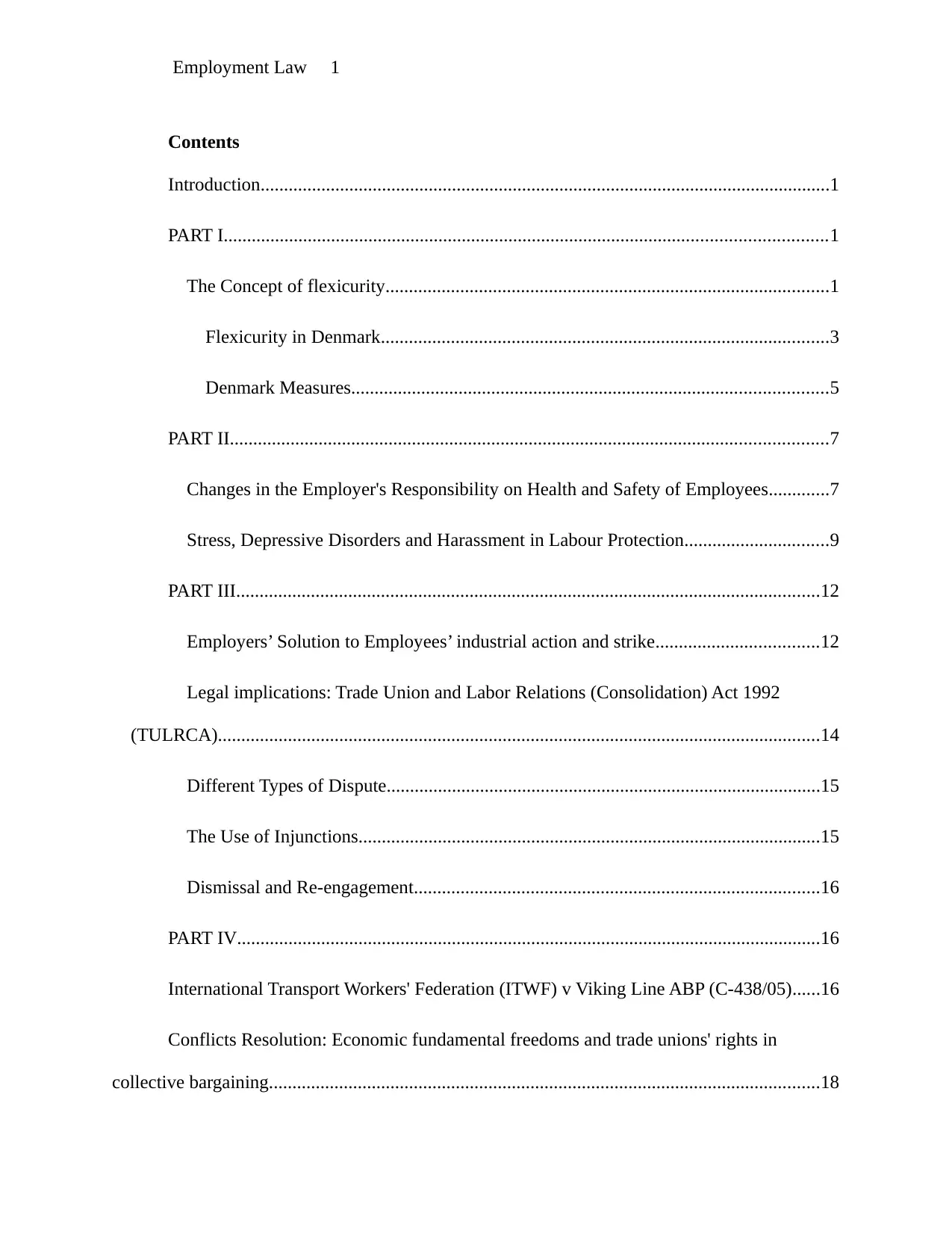
Employment Law 1
Contents
Introduction..........................................................................................................................1
PART I.................................................................................................................................1
The Concept of flexicurity...............................................................................................1
Flexicurity in Denmark................................................................................................3
Denmark Measures......................................................................................................5
PART II................................................................................................................................7
Changes in the Employer's Responsibility on Health and Safety of Employees.............7
Stress, Depressive Disorders and Harassment in Labour Protection...............................9
PART III.............................................................................................................................12
Employers’ Solution to Employees’ industrial action and strike...................................12
Legal implications: Trade Union and Labor Relations (Consolidation) Act 1992
(TULRCA).................................................................................................................................14
Different Types of Dispute.............................................................................................15
The Use of Injunctions...................................................................................................15
Dismissal and Re-engagement.......................................................................................16
PART IV.............................................................................................................................16
International Transport Workers' Federation (ITWF) v Viking Line ABP (C-438/05)......16
Conflicts Resolution: Economic fundamental freedoms and trade unions' rights in
collective bargaining......................................................................................................................18
Contents
Introduction..........................................................................................................................1
PART I.................................................................................................................................1
The Concept of flexicurity...............................................................................................1
Flexicurity in Denmark................................................................................................3
Denmark Measures......................................................................................................5
PART II................................................................................................................................7
Changes in the Employer's Responsibility on Health and Safety of Employees.............7
Stress, Depressive Disorders and Harassment in Labour Protection...............................9
PART III.............................................................................................................................12
Employers’ Solution to Employees’ industrial action and strike...................................12
Legal implications: Trade Union and Labor Relations (Consolidation) Act 1992
(TULRCA).................................................................................................................................14
Different Types of Dispute.............................................................................................15
The Use of Injunctions...................................................................................................15
Dismissal and Re-engagement.......................................................................................16
PART IV.............................................................................................................................16
International Transport Workers' Federation (ITWF) v Viking Line ABP (C-438/05)......16
Conflicts Resolution: Economic fundamental freedoms and trade unions' rights in
collective bargaining......................................................................................................................18

Employment Law 2
PART VI.............................................................................................................................20
Conclusion.........................................................................................................................23
Bibliography......................................................................................................................25
PART VI.............................................................................................................................20
Conclusion.........................................................................................................................23
Bibliography......................................................................................................................25
⊘ This is a preview!⊘
Do you want full access?
Subscribe today to unlock all pages.

Trusted by 1+ million students worldwide
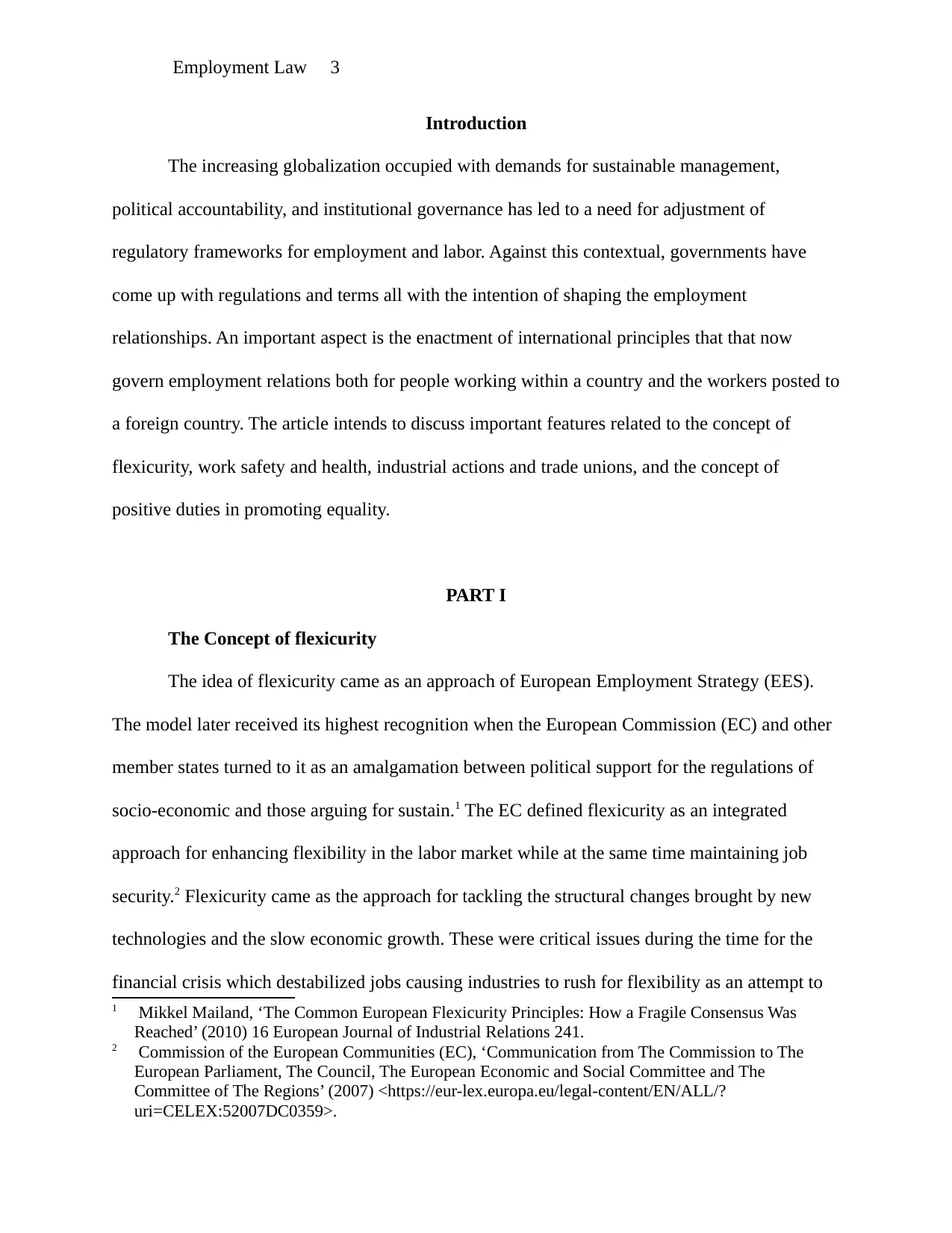
Employment Law 3
Introduction
The increasing globalization occupied with demands for sustainable management,
political accountability, and institutional governance has led to a need for adjustment of
regulatory frameworks for employment and labor. Against this contextual, governments have
come up with regulations and terms all with the intention of shaping the employment
relationships. An important aspect is the enactment of international principles that that now
govern employment relations both for people working within a country and the workers posted to
a foreign country. The article intends to discuss important features related to the concept of
flexicurity, work safety and health, industrial actions and trade unions, and the concept of
positive duties in promoting equality.
PART I
The Concept of flexicurity
The idea of flexicurity came as an approach of European Employment Strategy (EES).
The model later received its highest recognition when the European Commission (EC) and other
member states turned to it as an amalgamation between political support for the regulations of
socio-economic and those arguing for sustain.1 The EC defined flexicurity as an integrated
approach for enhancing flexibility in the labor market while at the same time maintaining job
security.2 Flexicurity came as the approach for tackling the structural changes brought by new
technologies and the slow economic growth. These were critical issues during the time for the
financial crisis which destabilized jobs causing industries to rush for flexibility as an attempt to
1 Mikkel Mailand, ‘The Common European Flexicurity Principles: How a Fragile Consensus Was
Reached’ (2010) 16 European Journal of Industrial Relations 241.
2 Commission of the European Communities (EC), ‘Communication from The Commission to The
European Parliament, The Council, The European Economic and Social Committee and The
Committee of The Regions’ (2007) <https://eur-lex.europa.eu/legal-content/EN/ALL/?
uri=CELEX:52007DC0359>.
Introduction
The increasing globalization occupied with demands for sustainable management,
political accountability, and institutional governance has led to a need for adjustment of
regulatory frameworks for employment and labor. Against this contextual, governments have
come up with regulations and terms all with the intention of shaping the employment
relationships. An important aspect is the enactment of international principles that that now
govern employment relations both for people working within a country and the workers posted to
a foreign country. The article intends to discuss important features related to the concept of
flexicurity, work safety and health, industrial actions and trade unions, and the concept of
positive duties in promoting equality.
PART I
The Concept of flexicurity
The idea of flexicurity came as an approach of European Employment Strategy (EES).
The model later received its highest recognition when the European Commission (EC) and other
member states turned to it as an amalgamation between political support for the regulations of
socio-economic and those arguing for sustain.1 The EC defined flexicurity as an integrated
approach for enhancing flexibility in the labor market while at the same time maintaining job
security.2 Flexicurity came as the approach for tackling the structural changes brought by new
technologies and the slow economic growth. These were critical issues during the time for the
financial crisis which destabilized jobs causing industries to rush for flexibility as an attempt to
1 Mikkel Mailand, ‘The Common European Flexicurity Principles: How a Fragile Consensus Was
Reached’ (2010) 16 European Journal of Industrial Relations 241.
2 Commission of the European Communities (EC), ‘Communication from The Commission to The
European Parliament, The Council, The European Economic and Social Committee and The
Committee of The Regions’ (2007) <https://eur-lex.europa.eu/legal-content/EN/ALL/?
uri=CELEX:52007DC0359>.
Paraphrase This Document
Need a fresh take? Get an instant paraphrase of this document with our AI Paraphraser
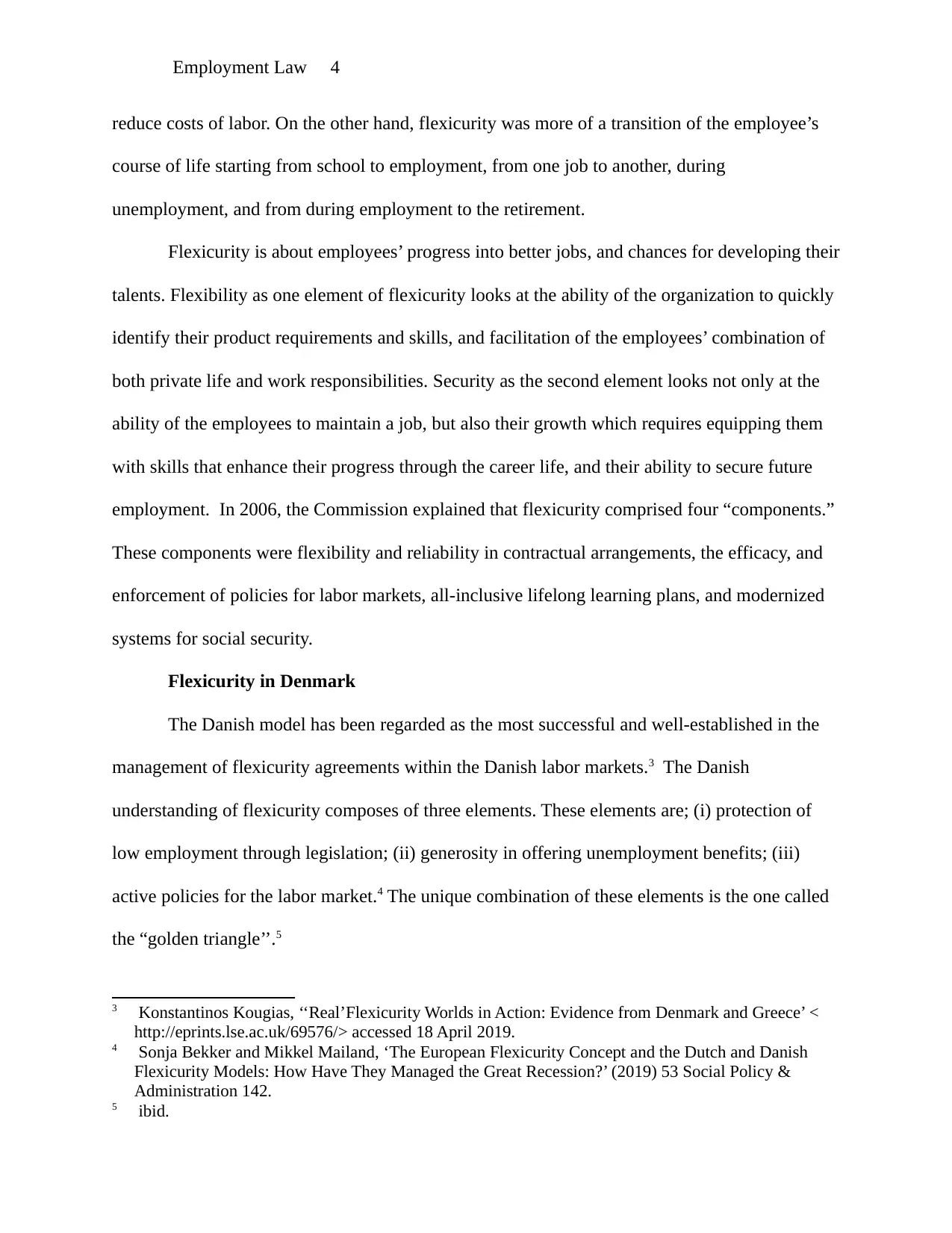
Employment Law 4
reduce costs of labor. On the other hand, flexicurity was more of a transition of the employee’s
course of life starting from school to employment, from one job to another, during
unemployment, and from during employment to the retirement.
Flexicurity is about employees’ progress into better jobs, and chances for developing their
talents. Flexibility as one element of flexicurity looks at the ability of the organization to quickly
identify their product requirements and skills, and facilitation of the employees’ combination of
both private life and work responsibilities. Security as the second element looks not only at the
ability of the employees to maintain a job, but also their growth which requires equipping them
with skills that enhance their progress through the career life, and their ability to secure future
employment. In 2006, the Commission explained that flexicurity comprised four “components.”
These components were flexibility and reliability in contractual arrangements, the efficacy, and
enforcement of policies for labor markets, all-inclusive lifelong learning plans, and modernized
systems for social security.
Flexicurity in Denmark
The Danish model has been regarded as the most successful and well-established in the
management of flexicurity agreements within the Danish labor markets.3 The Danish
understanding of flexicurity composes of three elements. These elements are; (i) protection of
low employment through legislation; (ii) generosity in offering unemployment benefits; (iii)
active policies for the labor market.4 The unique combination of these elements is the one called
the “golden triangle’’.5
3 Konstantinos Kougias, ‘‘Real’Flexicurity Worlds in Action: Evidence from Denmark and Greece’ <
http://eprints.lse.ac.uk/69576/> accessed 18 April 2019.
4 Sonja Bekker and Mikkel Mailand, ‘The European Flexicurity Concept and the Dutch and Danish
Flexicurity Models: How Have They Managed the Great Recession?’ (2019) 53 Social Policy &
Administration 142.
5 ibid.
reduce costs of labor. On the other hand, flexicurity was more of a transition of the employee’s
course of life starting from school to employment, from one job to another, during
unemployment, and from during employment to the retirement.
Flexicurity is about employees’ progress into better jobs, and chances for developing their
talents. Flexibility as one element of flexicurity looks at the ability of the organization to quickly
identify their product requirements and skills, and facilitation of the employees’ combination of
both private life and work responsibilities. Security as the second element looks not only at the
ability of the employees to maintain a job, but also their growth which requires equipping them
with skills that enhance their progress through the career life, and their ability to secure future
employment. In 2006, the Commission explained that flexicurity comprised four “components.”
These components were flexibility and reliability in contractual arrangements, the efficacy, and
enforcement of policies for labor markets, all-inclusive lifelong learning plans, and modernized
systems for social security.
Flexicurity in Denmark
The Danish model has been regarded as the most successful and well-established in the
management of flexicurity agreements within the Danish labor markets.3 The Danish
understanding of flexicurity composes of three elements. These elements are; (i) protection of
low employment through legislation; (ii) generosity in offering unemployment benefits; (iii)
active policies for the labor market.4 The unique combination of these elements is the one called
the “golden triangle’’.5
3 Konstantinos Kougias, ‘‘Real’Flexicurity Worlds in Action: Evidence from Denmark and Greece’ <
http://eprints.lse.ac.uk/69576/> accessed 18 April 2019.
4 Sonja Bekker and Mikkel Mailand, ‘The European Flexicurity Concept and the Dutch and Danish
Flexicurity Models: How Have They Managed the Great Recession?’ (2019) 53 Social Policy &
Administration 142.
5 ibid.
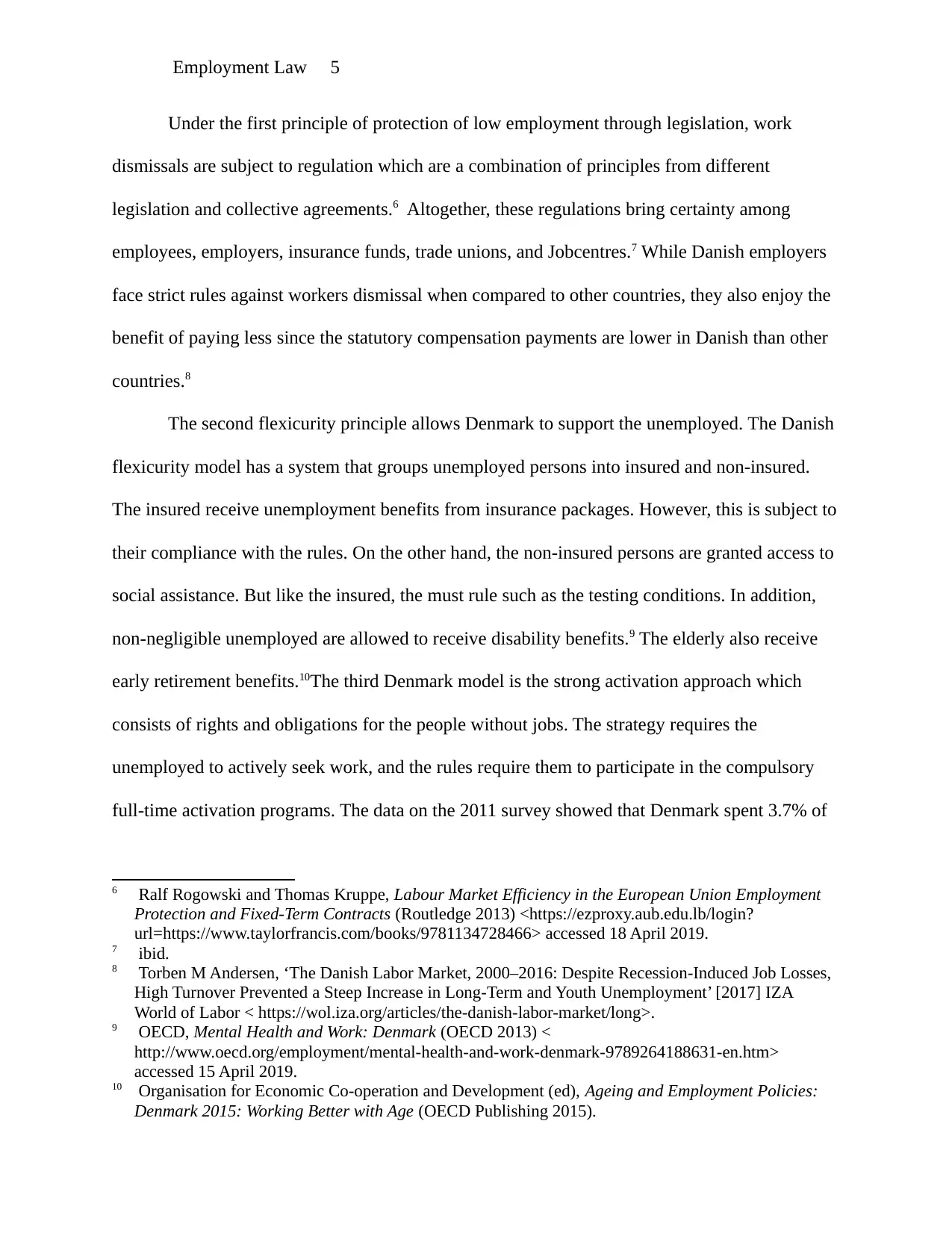
Employment Law 5
Under the first principle of protection of low employment through legislation, work
dismissals are subject to regulation which are a combination of principles from different
legislation and collective agreements.6 Altogether, these regulations bring certainty among
employees, employers, insurance funds, trade unions, and Jobcentres.7 While Danish employers
face strict rules against workers dismissal when compared to other countries, they also enjoy the
benefit of paying less since the statutory compensation payments are lower in Danish than other
countries.8
The second flexicurity principle allows Denmark to support the unemployed. The Danish
flexicurity model has a system that groups unemployed persons into insured and non-insured.
The insured receive unemployment benefits from insurance packages. However, this is subject to
their compliance with the rules. On the other hand, the non-insured persons are granted access to
social assistance. But like the insured, the must rule such as the testing conditions. In addition,
non-negligible unemployed are allowed to receive disability benefits.9 The elderly also receive
early retirement benefits.10The third Denmark model is the strong activation approach which
consists of rights and obligations for the people without jobs. The strategy requires the
unemployed to actively seek work, and the rules require them to participate in the compulsory
full-time activation programs. The data on the 2011 survey showed that Denmark spent 3.7% of
6 Ralf Rogowski and Thomas Kruppe, Labour Market Efficiency in the European Union Employment
Protection and Fixed-Term Contracts (Routledge 2013) <https://ezproxy.aub.edu.lb/login?
url=https://www.taylorfrancis.com/books/9781134728466> accessed 18 April 2019.
7 ibid.
8 Torben M Andersen, ‘The Danish Labor Market, 2000–2016: Despite Recession-Induced Job Losses,
High Turnover Prevented a Steep Increase in Long-Term and Youth Unemployment’ [2017] IZA
World of Labor < https://wol.iza.org/articles/the-danish-labor-market/long>.
9 OECD, Mental Health and Work: Denmark (OECD 2013) <
http://www.oecd.org/employment/mental-health-and-work-denmark-9789264188631-en.htm>
accessed 15 April 2019.
10 Organisation for Economic Co-operation and Development (ed), Ageing and Employment Policies:
Denmark 2015: Working Better with Age (OECD Publishing 2015).
Under the first principle of protection of low employment through legislation, work
dismissals are subject to regulation which are a combination of principles from different
legislation and collective agreements.6 Altogether, these regulations bring certainty among
employees, employers, insurance funds, trade unions, and Jobcentres.7 While Danish employers
face strict rules against workers dismissal when compared to other countries, they also enjoy the
benefit of paying less since the statutory compensation payments are lower in Danish than other
countries.8
The second flexicurity principle allows Denmark to support the unemployed. The Danish
flexicurity model has a system that groups unemployed persons into insured and non-insured.
The insured receive unemployment benefits from insurance packages. However, this is subject to
their compliance with the rules. On the other hand, the non-insured persons are granted access to
social assistance. But like the insured, the must rule such as the testing conditions. In addition,
non-negligible unemployed are allowed to receive disability benefits.9 The elderly also receive
early retirement benefits.10The third Denmark model is the strong activation approach which
consists of rights and obligations for the people without jobs. The strategy requires the
unemployed to actively seek work, and the rules require them to participate in the compulsory
full-time activation programs. The data on the 2011 survey showed that Denmark spent 3.7% of
6 Ralf Rogowski and Thomas Kruppe, Labour Market Efficiency in the European Union Employment
Protection and Fixed-Term Contracts (Routledge 2013) <https://ezproxy.aub.edu.lb/login?
url=https://www.taylorfrancis.com/books/9781134728466> accessed 18 April 2019.
7 ibid.
8 Torben M Andersen, ‘The Danish Labor Market, 2000–2016: Despite Recession-Induced Job Losses,
High Turnover Prevented a Steep Increase in Long-Term and Youth Unemployment’ [2017] IZA
World of Labor < https://wol.iza.org/articles/the-danish-labor-market/long>.
9 OECD, Mental Health and Work: Denmark (OECD 2013) <
http://www.oecd.org/employment/mental-health-and-work-denmark-9789264188631-en.htm>
accessed 15 April 2019.
10 Organisation for Economic Co-operation and Development (ed), Ageing and Employment Policies:
Denmark 2015: Working Better with Age (OECD Publishing 2015).
⊘ This is a preview!⊘
Do you want full access?
Subscribe today to unlock all pages.

Trusted by 1+ million students worldwide
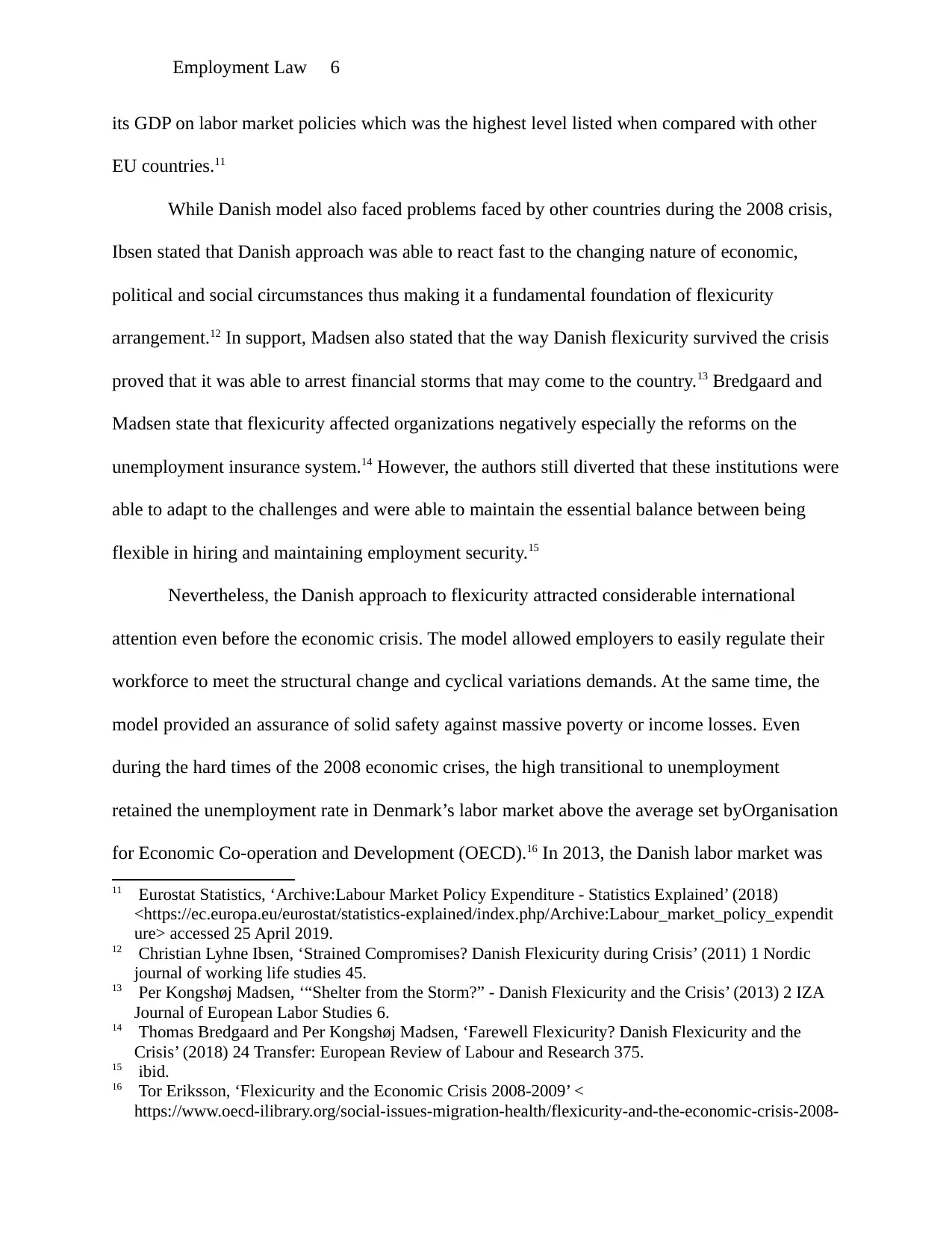
Employment Law 6
its GDP on labor market policies which was the highest level listed when compared with other
EU countries.11
While Danish model also faced problems faced by other countries during the 2008 crisis,
Ibsen stated that Danish approach was able to react fast to the changing nature of economic,
political and social circumstances thus making it a fundamental foundation of flexicurity
arrangement.12 In support, Madsen also stated that the way Danish flexicurity survived the crisis
proved that it was able to arrest financial storms that may come to the country.13 Bredgaard and
Madsen state that flexicurity affected organizations negatively especially the reforms on the
unemployment insurance system.14 However, the authors still diverted that these institutions were
able to adapt to the challenges and were able to maintain the essential balance between being
flexible in hiring and maintaining employment security.15
Nevertheless, the Danish approach to flexicurity attracted considerable international
attention even before the economic crisis. The model allowed employers to easily regulate their
workforce to meet the structural change and cyclical variations demands. At the same time, the
model provided an assurance of solid safety against massive poverty or income losses. Even
during the hard times of the 2008 economic crises, the high transitional to unemployment
retained the unemployment rate in Denmark’s labor market above the average set byOrganisation
for Economic Co-operation and Development (OECD).16 In 2013, the Danish labor market was
11 Eurostat Statistics, ‘Archive:Labour Market Policy Expenditure - Statistics Explained’ (2018)
<https://ec.europa.eu/eurostat/statistics-explained/index.php/Archive:Labour_market_policy_expendit
ure> accessed 25 April 2019.
12 Christian Lyhne Ibsen, ‘Strained Compromises? Danish Flexicurity during Crisis’ (2011) 1 Nordic
journal of working life studies 45.
13 Per Kongshøj Madsen, ‘“Shelter from the Storm?” - Danish Flexicurity and the Crisis’ (2013) 2 IZA
Journal of European Labor Studies 6.
14 Thomas Bredgaard and Per Kongshøj Madsen, ‘Farewell Flexicurity? Danish Flexicurity and the
Crisis’ (2018) 24 Transfer: European Review of Labour and Research 375.
15 ibid.
16 Tor Eriksson, ‘Flexicurity and the Economic Crisis 2008-2009’ <
https://www.oecd-ilibrary.org/social-issues-migration-health/flexicurity-and-the-economic-crisis-2008-
its GDP on labor market policies which was the highest level listed when compared with other
EU countries.11
While Danish model also faced problems faced by other countries during the 2008 crisis,
Ibsen stated that Danish approach was able to react fast to the changing nature of economic,
political and social circumstances thus making it a fundamental foundation of flexicurity
arrangement.12 In support, Madsen also stated that the way Danish flexicurity survived the crisis
proved that it was able to arrest financial storms that may come to the country.13 Bredgaard and
Madsen state that flexicurity affected organizations negatively especially the reforms on the
unemployment insurance system.14 However, the authors still diverted that these institutions were
able to adapt to the challenges and were able to maintain the essential balance between being
flexible in hiring and maintaining employment security.15
Nevertheless, the Danish approach to flexicurity attracted considerable international
attention even before the economic crisis. The model allowed employers to easily regulate their
workforce to meet the structural change and cyclical variations demands. At the same time, the
model provided an assurance of solid safety against massive poverty or income losses. Even
during the hard times of the 2008 economic crises, the high transitional to unemployment
retained the unemployment rate in Denmark’s labor market above the average set byOrganisation
for Economic Co-operation and Development (OECD).16 In 2013, the Danish labor market was
11 Eurostat Statistics, ‘Archive:Labour Market Policy Expenditure - Statistics Explained’ (2018)
<https://ec.europa.eu/eurostat/statistics-explained/index.php/Archive:Labour_market_policy_expendit
ure> accessed 25 April 2019.
12 Christian Lyhne Ibsen, ‘Strained Compromises? Danish Flexicurity during Crisis’ (2011) 1 Nordic
journal of working life studies 45.
13 Per Kongshøj Madsen, ‘“Shelter from the Storm?” - Danish Flexicurity and the Crisis’ (2013) 2 IZA
Journal of European Labor Studies 6.
14 Thomas Bredgaard and Per Kongshøj Madsen, ‘Farewell Flexicurity? Danish Flexicurity and the
Crisis’ (2018) 24 Transfer: European Review of Labour and Research 375.
15 ibid.
16 Tor Eriksson, ‘Flexicurity and the Economic Crisis 2008-2009’ <
https://www.oecd-ilibrary.org/social-issues-migration-health/flexicurity-and-the-economic-crisis-2008-
Paraphrase This Document
Need a fresh take? Get an instant paraphrase of this document with our AI Paraphraser
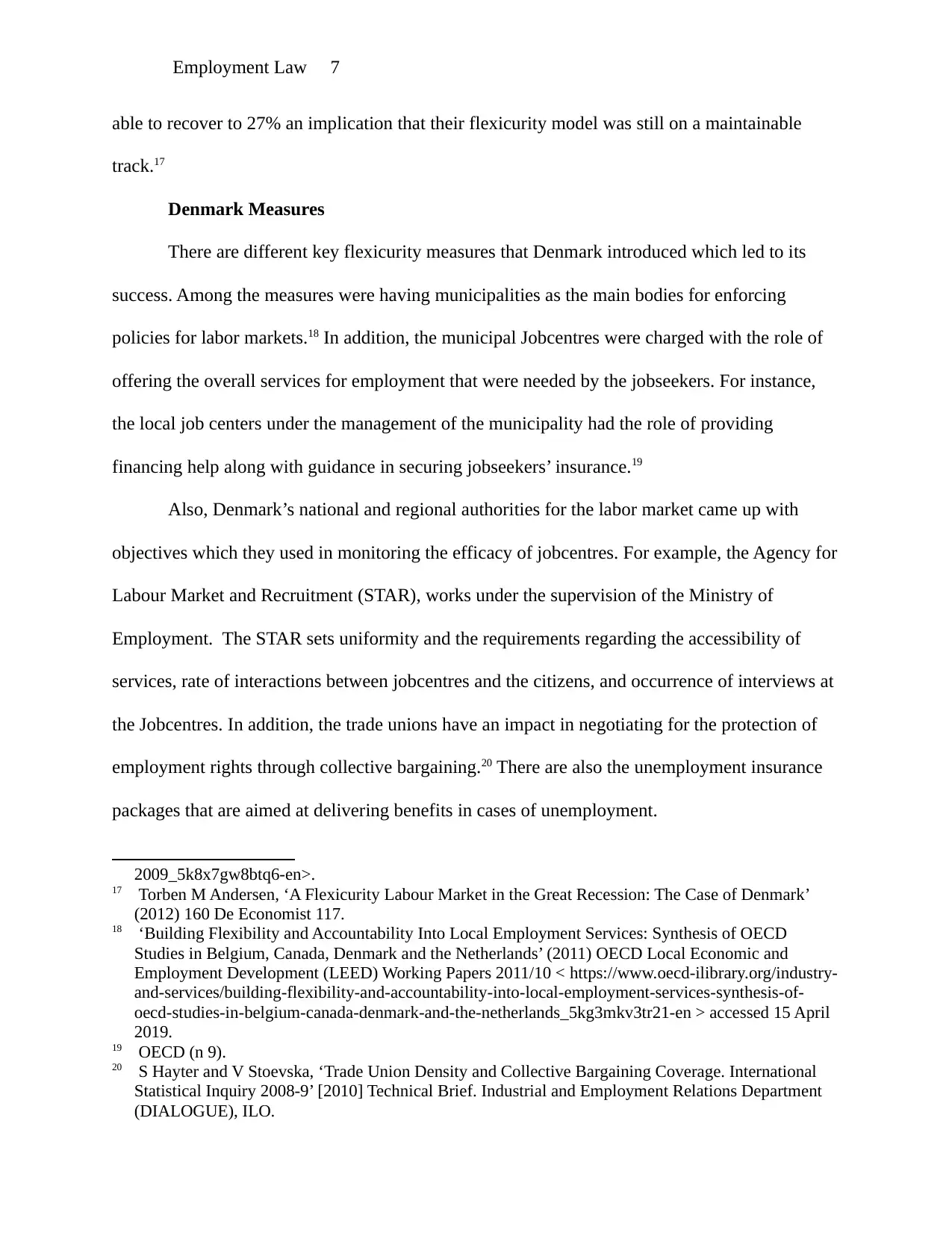
Employment Law 7
able to recover to 27% an implication that their flexicurity model was still on a maintainable
track.17
Denmark Measures
There are different key flexicurity measures that Denmark introduced which led to its
success. Among the measures were having municipalities as the main bodies for enforcing
policies for labor markets.18 In addition, the municipal Jobcentres were charged with the role of
offering the overall services for employment that were needed by the jobseekers. For instance,
the local job centers under the management of the municipality had the role of providing
financing help along with guidance in securing jobseekers’ insurance.19
Also, Denmark’s national and regional authorities for the labor market came up with
objectives which they used in monitoring the efficacy of jobcentres. For example, the Agency for
Labour Market and Recruitment (STAR), works under the supervision of the Ministry of
Employment. The STAR sets uniformity and the requirements regarding the accessibility of
services, rate of interactions between jobcentres and the citizens, and occurrence of interviews at
the Jobcentres. In addition, the trade unions have an impact in negotiating for the protection of
employment rights through collective bargaining.20 There are also the unemployment insurance
packages that are aimed at delivering benefits in cases of unemployment.
2009_5k8x7gw8btq6-en>.
17 Torben M Andersen, ‘A Flexicurity Labour Market in the Great Recession: The Case of Denmark’
(2012) 160 De Economist 117.
18 ‘Building Flexibility and Accountability Into Local Employment Services: Synthesis of OECD
Studies in Belgium, Canada, Denmark and the Netherlands’ (2011) OECD Local Economic and
Employment Development (LEED) Working Papers 2011/10 < https://www.oecd-ilibrary.org/industry-
and-services/building-flexibility-and-accountability-into-local-employment-services-synthesis-of-
oecd-studies-in-belgium-canada-denmark-and-the-netherlands_5kg3mkv3tr21-en > accessed 15 April
2019.
19 OECD (n 9).
20 S Hayter and V Stoevska, ‘Trade Union Density and Collective Bargaining Coverage. International
Statistical Inquiry 2008-9’ [2010] Technical Brief. Industrial and Employment Relations Department
(DIALOGUE), ILO.
able to recover to 27% an implication that their flexicurity model was still on a maintainable
track.17
Denmark Measures
There are different key flexicurity measures that Denmark introduced which led to its
success. Among the measures were having municipalities as the main bodies for enforcing
policies for labor markets.18 In addition, the municipal Jobcentres were charged with the role of
offering the overall services for employment that were needed by the jobseekers. For instance,
the local job centers under the management of the municipality had the role of providing
financing help along with guidance in securing jobseekers’ insurance.19
Also, Denmark’s national and regional authorities for the labor market came up with
objectives which they used in monitoring the efficacy of jobcentres. For example, the Agency for
Labour Market and Recruitment (STAR), works under the supervision of the Ministry of
Employment. The STAR sets uniformity and the requirements regarding the accessibility of
services, rate of interactions between jobcentres and the citizens, and occurrence of interviews at
the Jobcentres. In addition, the trade unions have an impact in negotiating for the protection of
employment rights through collective bargaining.20 There are also the unemployment insurance
packages that are aimed at delivering benefits in cases of unemployment.
2009_5k8x7gw8btq6-en>.
17 Torben M Andersen, ‘A Flexicurity Labour Market in the Great Recession: The Case of Denmark’
(2012) 160 De Economist 117.
18 ‘Building Flexibility and Accountability Into Local Employment Services: Synthesis of OECD
Studies in Belgium, Canada, Denmark and the Netherlands’ (2011) OECD Local Economic and
Employment Development (LEED) Working Papers 2011/10 < https://www.oecd-ilibrary.org/industry-
and-services/building-flexibility-and-accountability-into-local-employment-services-synthesis-of-
oecd-studies-in-belgium-canada-denmark-and-the-netherlands_5kg3mkv3tr21-en > accessed 15 April
2019.
19 OECD (n 9).
20 S Hayter and V Stoevska, ‘Trade Union Density and Collective Bargaining Coverage. International
Statistical Inquiry 2008-9’ [2010] Technical Brief. Industrial and Employment Relations Department
(DIALOGUE), ILO.
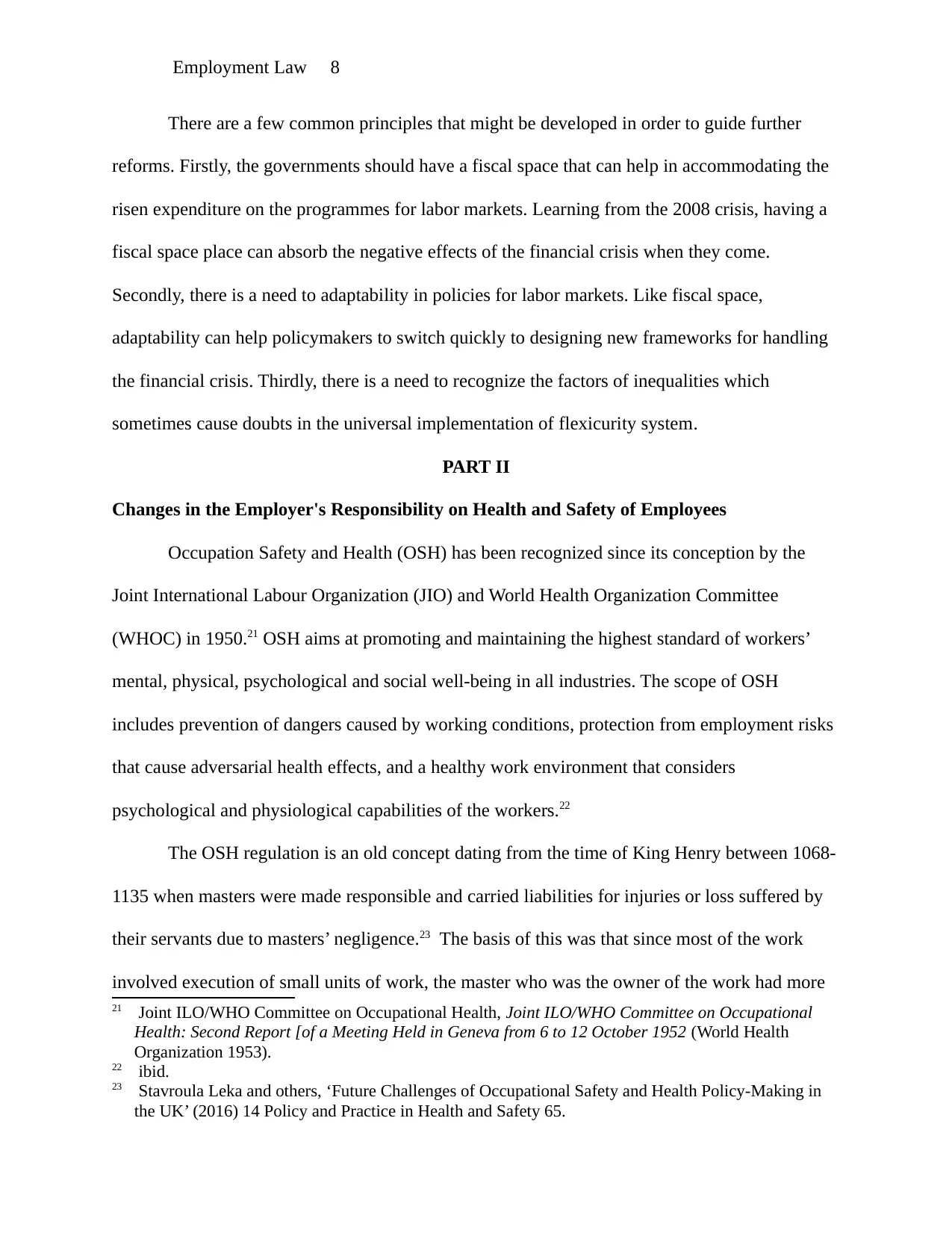
Employment Law 8
There are a few common principles that might be developed in order to guide further
reforms. Firstly, the governments should have a fiscal space that can help in accommodating the
risen expenditure on the programmes for labor markets. Learning from the 2008 crisis, having a
fiscal space place can absorb the negative effects of the financial crisis when they come.
Secondly, there is a need to adaptability in policies for labor markets. Like fiscal space,
adaptability can help policymakers to switch quickly to designing new frameworks for handling
the financial crisis. Thirdly, there is a need to recognize the factors of inequalities which
sometimes cause doubts in the universal implementation of flexicurity system.
PART II
Changes in the Employer's Responsibility on Health and Safety of Employees
Occupation Safety and Health (OSH) has been recognized since its conception by the
Joint International Labour Organization (JIO) and World Health Organization Committee
(WHOC) in 1950.21 OSH aims at promoting and maintaining the highest standard of workers’
mental, physical, psychological and social well-being in all industries. The scope of OSH
includes prevention of dangers caused by working conditions, protection from employment risks
that cause adversarial health effects, and a healthy work environment that considers
psychological and physiological capabilities of the workers.22
The OSH regulation is an old concept dating from the time of King Henry between 1068-
1135 when masters were made responsible and carried liabilities for injuries or loss suffered by
their servants due to masters’ negligence.23 The basis of this was that since most of the work
involved execution of small units of work, the master who was the owner of the work had more
21 Joint ILO/WHO Committee on Occupational Health, Joint ILO/WHO Committee on Occupational
Health: Second Report [of a Meeting Held in Geneva from 6 to 12 October 1952 (World Health
Organization 1953).
22 ibid.
23 Stavroula Leka and others, ‘Future Challenges of Occupational Safety and Health Policy-Making in
the UK’ (2016) 14 Policy and Practice in Health and Safety 65.
There are a few common principles that might be developed in order to guide further
reforms. Firstly, the governments should have a fiscal space that can help in accommodating the
risen expenditure on the programmes for labor markets. Learning from the 2008 crisis, having a
fiscal space place can absorb the negative effects of the financial crisis when they come.
Secondly, there is a need to adaptability in policies for labor markets. Like fiscal space,
adaptability can help policymakers to switch quickly to designing new frameworks for handling
the financial crisis. Thirdly, there is a need to recognize the factors of inequalities which
sometimes cause doubts in the universal implementation of flexicurity system.
PART II
Changes in the Employer's Responsibility on Health and Safety of Employees
Occupation Safety and Health (OSH) has been recognized since its conception by the
Joint International Labour Organization (JIO) and World Health Organization Committee
(WHOC) in 1950.21 OSH aims at promoting and maintaining the highest standard of workers’
mental, physical, psychological and social well-being in all industries. The scope of OSH
includes prevention of dangers caused by working conditions, protection from employment risks
that cause adversarial health effects, and a healthy work environment that considers
psychological and physiological capabilities of the workers.22
The OSH regulation is an old concept dating from the time of King Henry between 1068-
1135 when masters were made responsible and carried liabilities for injuries or loss suffered by
their servants due to masters’ negligence.23 The basis of this was that since most of the work
involved execution of small units of work, the master who was the owner of the work had more
21 Joint ILO/WHO Committee on Occupational Health, Joint ILO/WHO Committee on Occupational
Health: Second Report [of a Meeting Held in Geneva from 6 to 12 October 1952 (World Health
Organization 1953).
22 ibid.
23 Stavroula Leka and others, ‘Future Challenges of Occupational Safety and Health Policy-Making in
the UK’ (2016) 14 Policy and Practice in Health and Safety 65.
⊘ This is a preview!⊘
Do you want full access?
Subscribe today to unlock all pages.

Trusted by 1+ million students worldwide
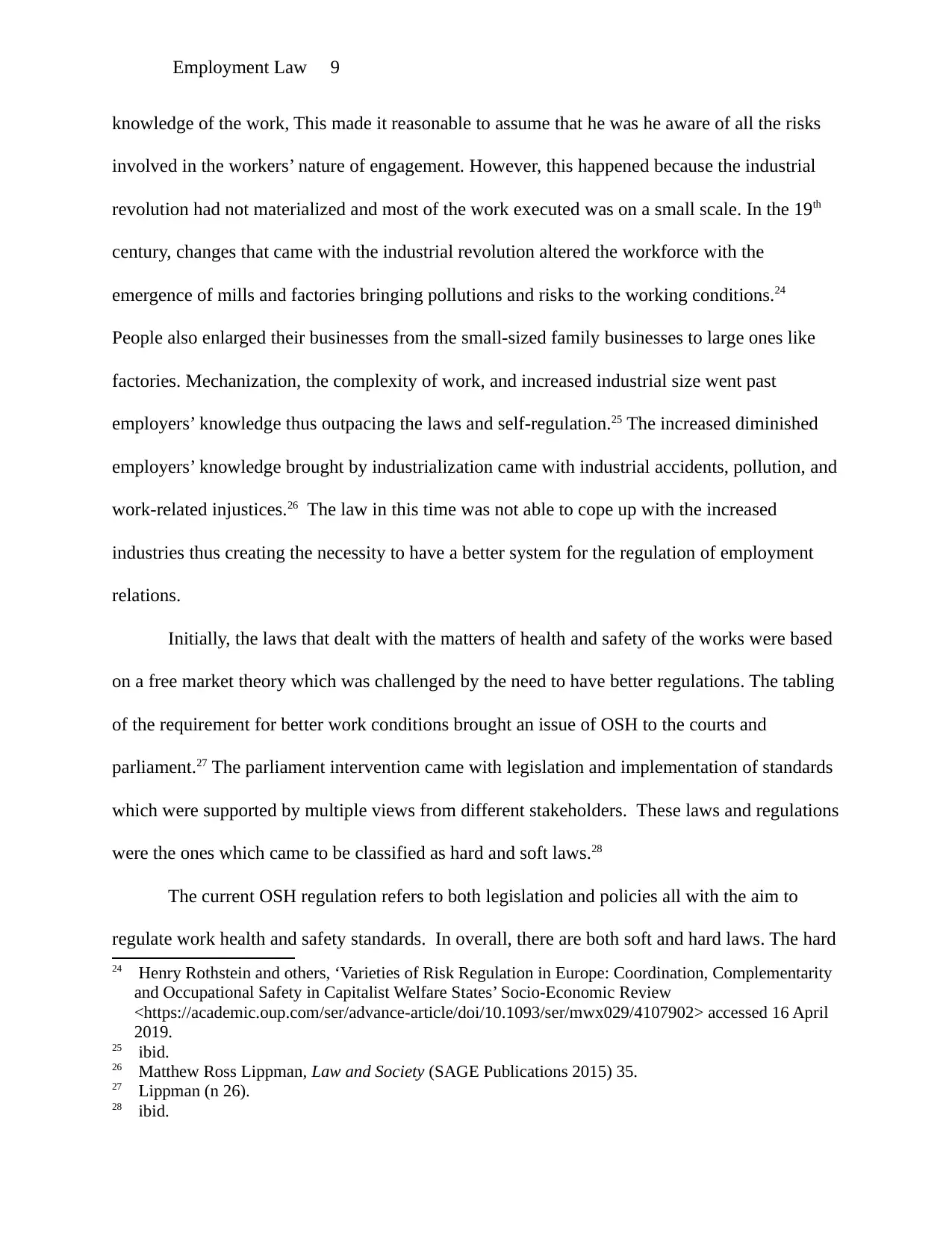
Employment Law 9
knowledge of the work, This made it reasonable to assume that he was he aware of all the risks
involved in the workers’ nature of engagement. However, this happened because the industrial
revolution had not materialized and most of the work executed was on a small scale. In the 19th
century, changes that came with the industrial revolution altered the workforce with the
emergence of mills and factories bringing pollutions and risks to the working conditions.24
People also enlarged their businesses from the small-sized family businesses to large ones like
factories. Mechanization, the complexity of work, and increased industrial size went past
employers’ knowledge thus outpacing the laws and self-regulation.25 The increased diminished
employers’ knowledge brought by industrialization came with industrial accidents, pollution, and
work-related injustices.26 The law in this time was not able to cope up with the increased
industries thus creating the necessity to have a better system for the regulation of employment
relations.
Initially, the laws that dealt with the matters of health and safety of the works were based
on a free market theory which was challenged by the need to have better regulations. The tabling
of the requirement for better work conditions brought an issue of OSH to the courts and
parliament.27 The parliament intervention came with legislation and implementation of standards
which were supported by multiple views from different stakeholders. These laws and regulations
were the ones which came to be classified as hard and soft laws.28
The current OSH regulation refers to both legislation and policies all with the aim to
regulate work health and safety standards. In overall, there are both soft and hard laws. The hard
24 Henry Rothstein and others, ‘Varieties of Risk Regulation in Europe: Coordination, Complementarity
and Occupational Safety in Capitalist Welfare States’ Socio-Economic Review
<https://academic.oup.com/ser/advance-article/doi/10.1093/ser/mwx029/4107902> accessed 16 April
2019.
25 ibid.
26 Matthew Ross Lippman, Law and Society (SAGE Publications 2015) 35.
27 Lippman (n 26).
28 ibid.
knowledge of the work, This made it reasonable to assume that he was he aware of all the risks
involved in the workers’ nature of engagement. However, this happened because the industrial
revolution had not materialized and most of the work executed was on a small scale. In the 19th
century, changes that came with the industrial revolution altered the workforce with the
emergence of mills and factories bringing pollutions and risks to the working conditions.24
People also enlarged their businesses from the small-sized family businesses to large ones like
factories. Mechanization, the complexity of work, and increased industrial size went past
employers’ knowledge thus outpacing the laws and self-regulation.25 The increased diminished
employers’ knowledge brought by industrialization came with industrial accidents, pollution, and
work-related injustices.26 The law in this time was not able to cope up with the increased
industries thus creating the necessity to have a better system for the regulation of employment
relations.
Initially, the laws that dealt with the matters of health and safety of the works were based
on a free market theory which was challenged by the need to have better regulations. The tabling
of the requirement for better work conditions brought an issue of OSH to the courts and
parliament.27 The parliament intervention came with legislation and implementation of standards
which were supported by multiple views from different stakeholders. These laws and regulations
were the ones which came to be classified as hard and soft laws.28
The current OSH regulation refers to both legislation and policies all with the aim to
regulate work health and safety standards. In overall, there are both soft and hard laws. The hard
24 Henry Rothstein and others, ‘Varieties of Risk Regulation in Europe: Coordination, Complementarity
and Occupational Safety in Capitalist Welfare States’ Socio-Economic Review
<https://academic.oup.com/ser/advance-article/doi/10.1093/ser/mwx029/4107902> accessed 16 April
2019.
25 ibid.
26 Matthew Ross Lippman, Law and Society (SAGE Publications 2015) 35.
27 Lippman (n 26).
28 ibid.
Paraphrase This Document
Need a fresh take? Get an instant paraphrase of this document with our AI Paraphraser
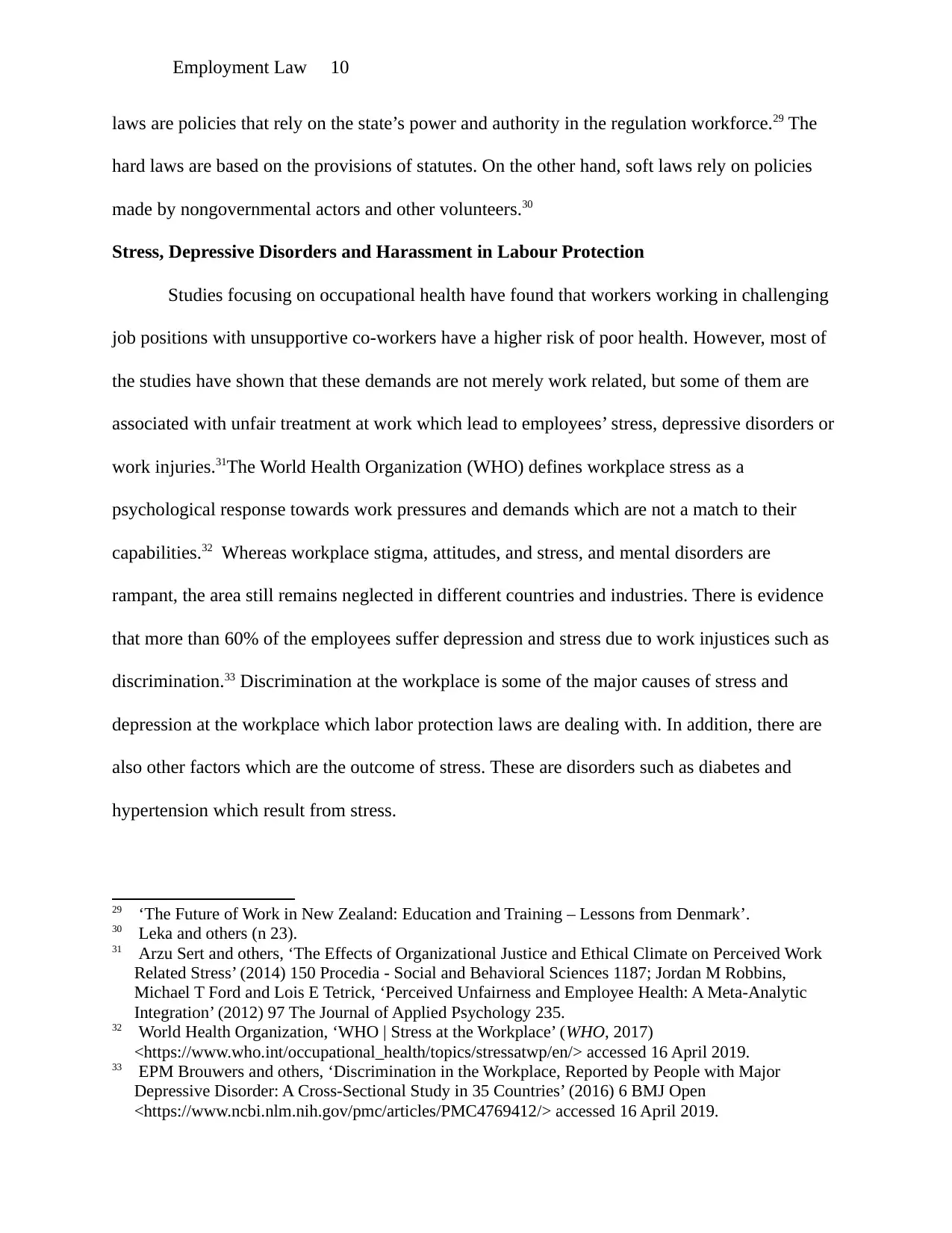
Employment Law 10
laws are policies that rely on the state’s power and authority in the regulation workforce.29 The
hard laws are based on the provisions of statutes. On the other hand, soft laws rely on policies
made by nongovernmental actors and other volunteers.30
Stress, Depressive Disorders and Harassment in Labour Protection
Studies focusing on occupational health have found that workers working in challenging
job positions with unsupportive co-workers have a higher risk of poor health. However, most of
the studies have shown that these demands are not merely work related, but some of them are
associated with unfair treatment at work which lead to employees’ stress, depressive disorders or
work injuries.31The World Health Organization (WHO) defines workplace stress as a
psychological response towards work pressures and demands which are not a match to their
capabilities.32 Whereas workplace stigma, attitudes, and stress, and mental disorders are
rampant, the area still remains neglected in different countries and industries. There is evidence
that more than 60% of the employees suffer depression and stress due to work injustices such as
discrimination.33 Discrimination at the workplace is some of the major causes of stress and
depression at the workplace which labor protection laws are dealing with. In addition, there are
also other factors which are the outcome of stress. These are disorders such as diabetes and
hypertension which result from stress.
29 ‘The Future of Work in New Zealand: Education and Training – Lessons from Denmark’.
30 Leka and others (n 23).
31 Arzu Sert and others, ‘The Effects of Organizational Justice and Ethical Climate on Perceived Work
Related Stress’ (2014) 150 Procedia - Social and Behavioral Sciences 1187; Jordan M Robbins,
Michael T Ford and Lois E Tetrick, ‘Perceived Unfairness and Employee Health: A Meta-Analytic
Integration’ (2012) 97 The Journal of Applied Psychology 235.
32 World Health Organization, ‘WHO | Stress at the Workplace’ (WHO, 2017)
<https://www.who.int/occupational_health/topics/stressatwp/en/> accessed 16 April 2019.
33 EPM Brouwers and others, ‘Discrimination in the Workplace, Reported by People with Major
Depressive Disorder: A Cross-Sectional Study in 35 Countries’ (2016) 6 BMJ Open
<https://www.ncbi.nlm.nih.gov/pmc/articles/PMC4769412/> accessed 16 April 2019.
laws are policies that rely on the state’s power and authority in the regulation workforce.29 The
hard laws are based on the provisions of statutes. On the other hand, soft laws rely on policies
made by nongovernmental actors and other volunteers.30
Stress, Depressive Disorders and Harassment in Labour Protection
Studies focusing on occupational health have found that workers working in challenging
job positions with unsupportive co-workers have a higher risk of poor health. However, most of
the studies have shown that these demands are not merely work related, but some of them are
associated with unfair treatment at work which lead to employees’ stress, depressive disorders or
work injuries.31The World Health Organization (WHO) defines workplace stress as a
psychological response towards work pressures and demands which are not a match to their
capabilities.32 Whereas workplace stigma, attitudes, and stress, and mental disorders are
rampant, the area still remains neglected in different countries and industries. There is evidence
that more than 60% of the employees suffer depression and stress due to work injustices such as
discrimination.33 Discrimination at the workplace is some of the major causes of stress and
depression at the workplace which labor protection laws are dealing with. In addition, there are
also other factors which are the outcome of stress. These are disorders such as diabetes and
hypertension which result from stress.
29 ‘The Future of Work in New Zealand: Education and Training – Lessons from Denmark’.
30 Leka and others (n 23).
31 Arzu Sert and others, ‘The Effects of Organizational Justice and Ethical Climate on Perceived Work
Related Stress’ (2014) 150 Procedia - Social and Behavioral Sciences 1187; Jordan M Robbins,
Michael T Ford and Lois E Tetrick, ‘Perceived Unfairness and Employee Health: A Meta-Analytic
Integration’ (2012) 97 The Journal of Applied Psychology 235.
32 World Health Organization, ‘WHO | Stress at the Workplace’ (WHO, 2017)
<https://www.who.int/occupational_health/topics/stressatwp/en/> accessed 16 April 2019.
33 EPM Brouwers and others, ‘Discrimination in the Workplace, Reported by People with Major
Depressive Disorder: A Cross-Sectional Study in 35 Countries’ (2016) 6 BMJ Open
<https://www.ncbi.nlm.nih.gov/pmc/articles/PMC4769412/> accessed 16 April 2019.
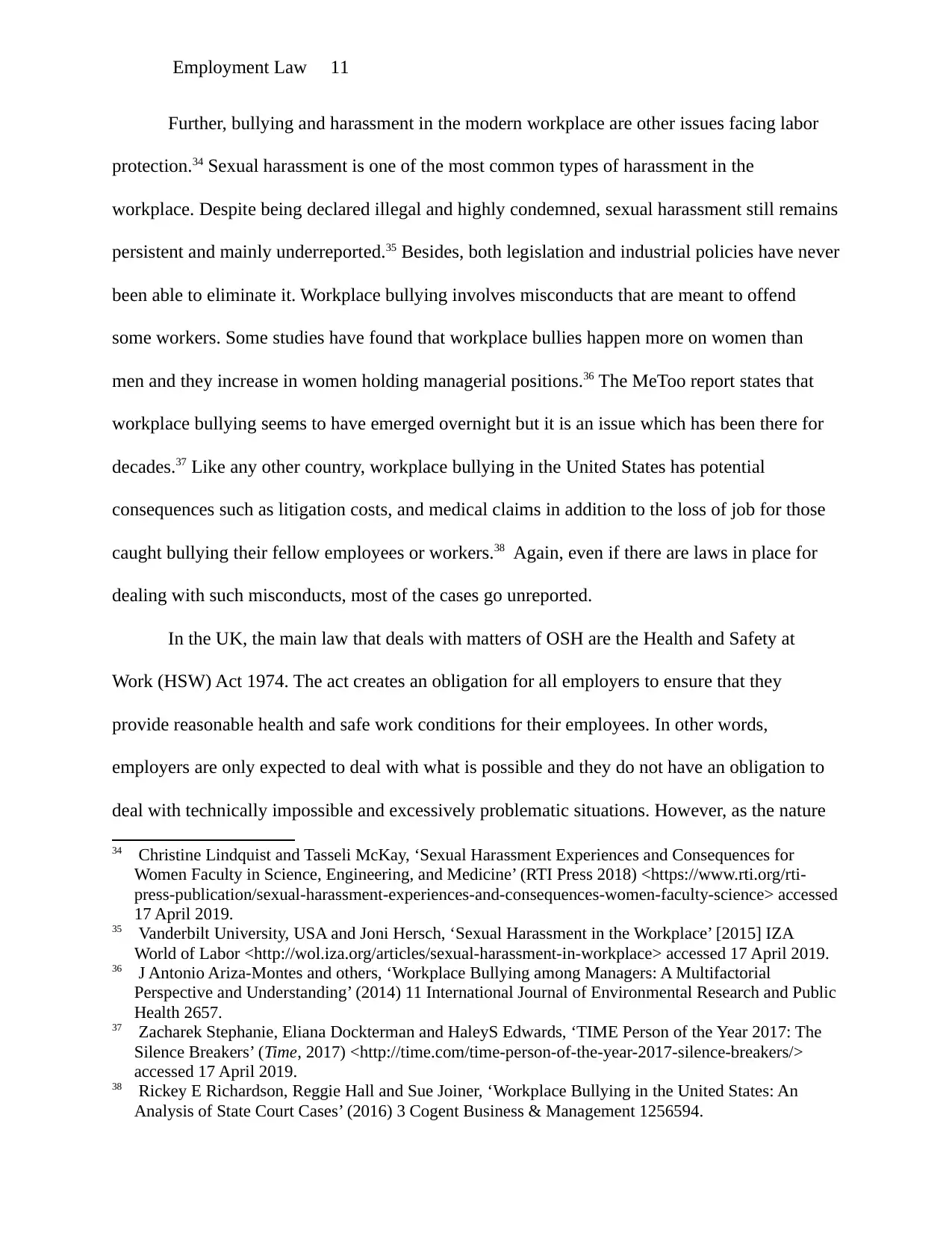
Employment Law 11
Further, bullying and harassment in the modern workplace are other issues facing labor
protection.34 Sexual harassment is one of the most common types of harassment in the
workplace. Despite being declared illegal and highly condemned, sexual harassment still remains
persistent and mainly underreported.35 Besides, both legislation and industrial policies have never
been able to eliminate it. Workplace bullying involves misconducts that are meant to offend
some workers. Some studies have found that workplace bullies happen more on women than
men and they increase in women holding managerial positions.36 The MeToo report states that
workplace bullying seems to have emerged overnight but it is an issue which has been there for
decades.37 Like any other country, workplace bullying in the United States has potential
consequences such as litigation costs, and medical claims in addition to the loss of job for those
caught bullying their fellow employees or workers.38 Again, even if there are laws in place for
dealing with such misconducts, most of the cases go unreported.
In the UK, the main law that deals with matters of OSH are the Health and Safety at
Work (HSW) Act 1974. The act creates an obligation for all employers to ensure that they
provide reasonable health and safe work conditions for their employees. In other words,
employers are only expected to deal with what is possible and they do not have an obligation to
deal with technically impossible and excessively problematic situations. However, as the nature
34 Christine Lindquist and Tasseli McKay, ‘Sexual Harassment Experiences and Consequences for
Women Faculty in Science, Engineering, and Medicine’ (RTI Press 2018) <https://www.rti.org/rti-
press-publication/sexual-harassment-experiences-and-consequences-women-faculty-science> accessed
17 April 2019.
35 Vanderbilt University, USA and Joni Hersch, ‘Sexual Harassment in the Workplace’ [2015] IZA
World of Labor <http://wol.iza.org/articles/sexual-harassment-in-workplace> accessed 17 April 2019.
36 J Antonio Ariza-Montes and others, ‘Workplace Bullying among Managers: A Multifactorial
Perspective and Understanding’ (2014) 11 International Journal of Environmental Research and Public
Health 2657.
37 Zacharek Stephanie, Eliana Dockterman and HaleyS Edwards, ‘TIME Person of the Year 2017: The
Silence Breakers’ (Time, 2017) <http://time.com/time-person-of-the-year-2017-silence-breakers/>
accessed 17 April 2019.
38 Rickey E Richardson, Reggie Hall and Sue Joiner, ‘Workplace Bullying in the United States: An
Analysis of State Court Cases’ (2016) 3 Cogent Business & Management 1256594.
Further, bullying and harassment in the modern workplace are other issues facing labor
protection.34 Sexual harassment is one of the most common types of harassment in the
workplace. Despite being declared illegal and highly condemned, sexual harassment still remains
persistent and mainly underreported.35 Besides, both legislation and industrial policies have never
been able to eliminate it. Workplace bullying involves misconducts that are meant to offend
some workers. Some studies have found that workplace bullies happen more on women than
men and they increase in women holding managerial positions.36 The MeToo report states that
workplace bullying seems to have emerged overnight but it is an issue which has been there for
decades.37 Like any other country, workplace bullying in the United States has potential
consequences such as litigation costs, and medical claims in addition to the loss of job for those
caught bullying their fellow employees or workers.38 Again, even if there are laws in place for
dealing with such misconducts, most of the cases go unreported.
In the UK, the main law that deals with matters of OSH are the Health and Safety at
Work (HSW) Act 1974. The act creates an obligation for all employers to ensure that they
provide reasonable health and safe work conditions for their employees. In other words,
employers are only expected to deal with what is possible and they do not have an obligation to
deal with technically impossible and excessively problematic situations. However, as the nature
34 Christine Lindquist and Tasseli McKay, ‘Sexual Harassment Experiences and Consequences for
Women Faculty in Science, Engineering, and Medicine’ (RTI Press 2018) <https://www.rti.org/rti-
press-publication/sexual-harassment-experiences-and-consequences-women-faculty-science> accessed
17 April 2019.
35 Vanderbilt University, USA and Joni Hersch, ‘Sexual Harassment in the Workplace’ [2015] IZA
World of Labor <http://wol.iza.org/articles/sexual-harassment-in-workplace> accessed 17 April 2019.
36 J Antonio Ariza-Montes and others, ‘Workplace Bullying among Managers: A Multifactorial
Perspective and Understanding’ (2014) 11 International Journal of Environmental Research and Public
Health 2657.
37 Zacharek Stephanie, Eliana Dockterman and HaleyS Edwards, ‘TIME Person of the Year 2017: The
Silence Breakers’ (Time, 2017) <http://time.com/time-person-of-the-year-2017-silence-breakers/>
accessed 17 April 2019.
38 Rickey E Richardson, Reggie Hall and Sue Joiner, ‘Workplace Bullying in the United States: An
Analysis of State Court Cases’ (2016) 3 Cogent Business & Management 1256594.
⊘ This is a preview!⊘
Do you want full access?
Subscribe today to unlock all pages.

Trusted by 1+ million students worldwide
1 out of 29
Related Documents
Your All-in-One AI-Powered Toolkit for Academic Success.
+13062052269
info@desklib.com
Available 24*7 on WhatsApp / Email
![[object Object]](/_next/static/media/star-bottom.7253800d.svg)
Unlock your academic potential
Copyright © 2020–2025 A2Z Services. All Rights Reserved. Developed and managed by ZUCOL.





